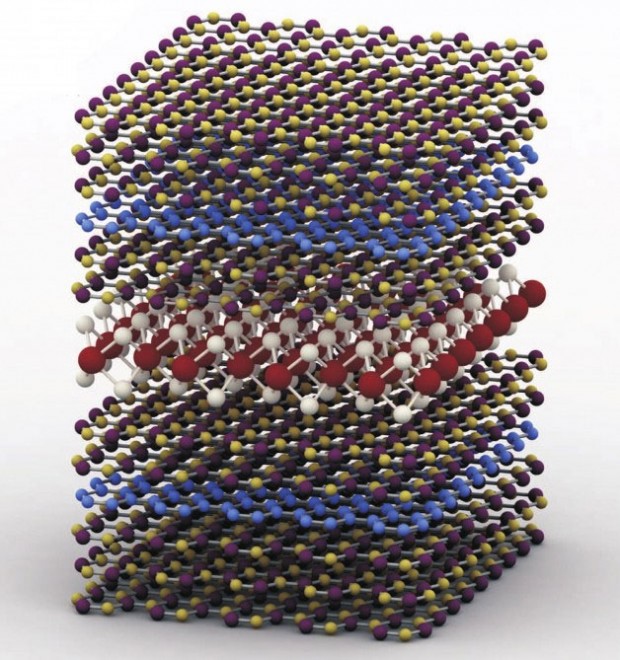در حالی که کمپانیهای پیشروی تولید صفحهنمایش چون الجی و سامسونگ در حال تولید صفحهنمایشهای انعطافپذیر خود هستند، دانشمندان اخیرا به روشی کاملا نو برای تولید این صفحهنمایشها دست یافتهاند.
تا امروز صفحهنمایشهای نیمه شفاف و انعطافپذیر بخشی از فیلمهای علمی تخیلی بوده است، اما به لطف ویژگیهای خارق العاده گرافین، دانشمندان دانشگاه منچستر موفق به روشی برای به واقعیت رساندن آن شدهاند.
نتیجه تحقیقات مشترک دانشگاه منچستر و شفیلد نشان میدهد که میتوان از مواد دو بعدی چون گرافین در تولید صفحهنمایشهای شفاف و انعطافپذیر استفاده کرد.این تیم تحقیقاتی به رهبری کنستانتین نووسلف توانستهاند با بهرهگیری از این تحقیقات، LED هایی در مقیاس اتمی تولید کنند.
آقای نووسلف در سال 2010 نیز توانسته بود جایزه نوبل فیزیک را به واسطه تولید نمونه واقعی و ایزولهشده گرافین کسب کند.
این تحقیقات راه را برای نسل بعدی صفحهنمایشهای موبایل انعطافپذیر، مقاوم، با مصرف انرژی پایین و نیمهشفاف بازخواهد کرد. صفحهنمایش تولیدی این تیم دارای ضخامتی تنها 10 تا 40 اتمی است؛ ضخامتی بسیار پایین که میتواند به عنوان یک تحول انقلابی در تولید صفحهنمایشها معرفی شود.
لایه تکاتمی گرافین نخستین بار در سال 2004 و در دانشگاه منچستر تولید شد. از آن زمان تاکنون مزایای بسیاری برای این ماده پیشنهاد شده، اما بیشترین تمرکز تحقیقاتی آن در حوزه دستگاههای الکترونیکی بوده است.
پس از تولید گرافین، مواد دو بعدی جدیدی چون بورون نیترید و مولیبدن دیسولفید نیز توانستهاند حوزههای تحقیقاتی وسیعی را برای دانشمندان دنیا به وجود بیاروند.
فردی ویترز از محققین برجسته این پروژه میگوید: «به دلیل استفاده از تنها چند لایه اتمی ساخته شده از مواد دو بعدی، صفحهنمایش ما قابلیت انعطافپذیری و شفافیت را کسب کرده است. این کشف میتواند در تولید دستگاههای معمولی تصویری و لیزرها تا دستگاههای بسیار پیچیدهتر کاربرد داشته باشد.»
کنستانتین نووسلف رهبر پروژه نیز پیرامون تولید این LED میگوید: «با قراردادن مواد دو بعدی چند لایه (Heterostructures) بر روی مواد با قابلیت کشسان و شفاف، ما روشی پایه ای برای تولید دستگاههای الکترونیکی انعطافپذیر و شفاف ارائه کردیم. انتظار داریم که با افزایش کریستالهای دو بعدی و بهبود کیفیت الکترونیکی آنها بتوانیم عملکردها و کاربردهای بسیار بیشتری برای مواد دو بعدی چند لایه ای ارائه کنیم.»
تاکنون کاربردهای بسیاری چون تولید لباسهای ضدگلوله، باتریهای با عمر بسیار طولانی و ظرفیت بالا برای گرافین ارائه شده و از آن به عنوان ماده انقلابی دوران ما یاد میشود. علیرغم اثبات کاربرد گسترده آن، هنوز محصولات بسیار کمی مبتنی بر گرافین در بازار یافت میشود.
منبع : gizmag
Flexible graphene-based LED clears the way for flexible displays
Flexible graphene-based LED clears the way for flexible displays
Researchers from the University of Manchester and University of Sheffield have developed a new prototype semi-transparent, graphene-based LED device that could form the basis of flexible screens for use in the next-generation of mobile phones, tablets and televisions. The incredibly thin display was created using sandwiched “heterostructures”, is only 10-40 atoms thick and emits a sheet of light across its entire surface.
The University of Manchester has a long history of working with graphene, with Sir Andre Geim and Sir Kostya Novoselov first isolating the material of single-atom thickness at the University via mechanical exfoliation (using adhesive tape) back in 2004. Since then, research has also branched out into other promising 2D material structures, including boron nitiride and molybdenum disulphide.
The culmination of these areas of experimentation is the new 2D LED semiconductor built by a team led by Novoselov using a combination of metallic graphene, insulating hexagonal boron nitride and various semiconducting monolayers. It is this construction using LEDs engineered at an atomic level that allowed the team to produce their breakthrough device. As such, the work shows that graphene (combined with other flexible 2D materials) is not just limited to simple electronic displays, but could be exploited to create light emitting devices that are not only incredibly thin, but flexible, semi-transparent, and intrinsically bright.
“By preparing the heterostructures on elastic and transparent substrates, we show that they can provide the basis for flexible and semi-transparent electronics,” said Novoselov.
This inherent elasticity and translucence also means that the device shows promise as an alternative to current LCD or conventional LED technology, potentially offering everything from modest lighting products to multifaceted graphical displays.
“We envisage a new generation of optoelectronic devices to stem from this work, from simple transparent lighting and lasers and to more complex applications,” said Freddie Withers, Royal Academy of Engineering Research Fellow at The University of Manchester.
The heterostructures (or van der Waals heterostructures, to give them their full name) are made by joining different materials, usually in layers, and with the materials joined directly at the atomic level. The heterostructures used in the new device essentially create an electron attractive force that the researchers have used to construct quantum wells to control the movement of electrons and make the device emit light.
In effect, these quantum wells (where electrons and “holes” both see a lower energy in the “well” layer, hence the name) use their special properties for the confinement of charge carriers (the electrons and holes) in thin layers at a quantum level. A subsequent change in energy states as exchanges are made in potential produces photons and, therefore, light.
“The range of functionalities for the demonstrated heterostructures is expected to grow further on increasing the number of available 2D crystals and improving their electronic quality,” said Novoselov.
According to the researchers, the reliability and stability of the materials in the prototype device also shows promise for future commercial manufacturing and applications.
“The novel LED structures are robust and show no significant change in performance over many weeks of measurements,” added Professor Alexander Tartakovskii, from The University of Sheffield. “Despite the early days in the raw materials manufacture, the quantum efficiency (photons emitted per electron injected) is already comparable to organic LEDs.”
The research was recently published in the journal Nature Materials.
 گجت نیوز آخرین اخبار تکنولوژی، علم و خودرو
گجت نیوز آخرین اخبار تکنولوژی، علم و خودرو 







